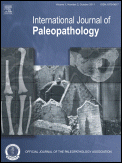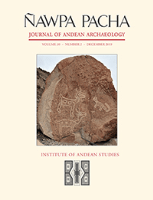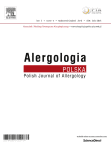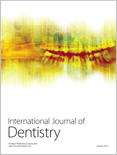
International Journal of Paleopathology
Scope & Guideline
Decoding the Health Narratives of Our Ancestors
Introduction
Aims and Scopes
- Paleopathological Analysis of Skeletal Remains:
The journal aims to publish research that provides detailed paleopathological analyses of human and animal skeletal remains, helping to identify diseases and health conditions present in past populations. - Interdisciplinary Methodologies:
It encourages the use of interdisciplinary methodologies, combining techniques from archaeology, anthropology, and medical sciences to enhance the understanding of past health issues. - Historical Context of Diseases:
The journal addresses the historical context of diseases, examining how social, environmental, and cultural factors influenced health and disease patterns in different populations. - Bioarchaeology of Care:
A significant focus is on the bioarchaeology of care, exploring how past societies managed health issues and disabilities, providing insights into their social structures. - Rare Diseases and Conditions:
The journal highlights studies on rare diseases and conditions in ancient populations, contributing to the understanding of their prevalence and impact on health.
Trending and Emerging
- Digital and Technological Applications in Paleopathology:
There is a growing trend towards utilizing digital tools and technologies, such as 3D imaging and digital atlases, to enhance the analysis of skeletal remains and improve diagnostic accuracy. - Paleoepidemiology and Population Health Studies:
An emerging focus on paleoepidemiology reflects a trend towards understanding health patterns over time, examining how diseases affected populations in historical contexts. - Interdisciplinary Approaches to Disability Studies:
A significant increase in research addressing disabilities from a bioarchaeological perspective indicates a trend towards understanding how societies cared for individuals with impairments throughout history. - Integration of Genetic and Molecular Techniques:
There is a marked increase in studies integrating genetic analyses and ancient DNA recovery techniques to understand the genetic factors associated with diseases in ancient populations. - Environmental and Sociocultural Influences on Health:
Emerging themes increasingly explore how environmental and sociocultural changes influenced health, disease prevalence, and management throughout history.
Declining or Waning
- Generalized Studies of Common Diseases:
Research focusing on common diseases without specific historical or cultural context has declined, as there is a growing emphasis on unique case studies that provide deeper insights into specific populations. - Over-reliance on Traditional Diagnostic Methods:
There appears to be a decrease in studies relying solely on traditional diagnostic methods without integrating advanced imaging techniques or interdisciplinary approaches, which are increasingly seen as essential for robust paleopathological research. - Focus on Non-Human Paleopathology:
There is a noticeable waning interest in the paleopathology of non-human species, as the journal has shifted towards more human-centric studies, particularly those addressing human health and disease. - General Historical Surveys:
Broad historical surveys of diseases are less common, as researchers now prefer focused studies that examine specific case studies or populations in detail.
Similar Journals

Anthropologie-International Journal of Human Diversity and Evolution
Innovating Perspectives on Human DiversityAnthropologie-International Journal of Human Diversity and Evolution is a prominent peer-reviewed journal published by the esteemed MORAVIAN MUSEUM in the heart of the Czech Republic. With a focus on anthropology, this journal serves as a vital platform for the dissemination of innovative research that explores human diversity and evolutionary studies. The journal operates under a rigorous academic framework and is categorized in the Q3 quartile for anthropology in 2023, reflecting its significance in the field. Although it does not currently offer open access options, Anthropologie facilitates the exchange of knowledge through its carefully curated articles spanning diverse topics within human evolution. Its Scopus ranking (320 out of 502 in social sciences) underscores its role as a relevant source for scholars and professionals alike, fostering dialogue and advancements in understanding human diversity. Researchers, students, and practitioners can look forward to engaging content that not only enlightens but also inspires further inquiry into anthropological studies.

Stratum Plus
Fostering Academic Excellence in the Heart of MoldovaStratum Plus, published by HIGH ANTHROPOLOGICAL SCH UNIV, is a distinguished academic journal based in Moldova that focuses on the fields of Anthropology, Archeology, and History. With an impressive impact factor reflecting its stature—ranked in the Q2 category for both Anthropology and Archeology, and Q1 for Archeology in the arts and humanities—this journal is a vital resource for scholars, professionals, and students alike. The journal's comprehensive scope encompasses a wide array of interdisciplinary studies, making it a beacon for innovative research and critical discourse within these disciplines. Since its inception in 2014, Stratum Plus has strived to foster academic excellence and knowledge dissemination, thus playing a crucial role in shaping contemporary anthropological and archaeological thought. While currently not available as Open Access, the journal maintains a strong online presence, with access options available through institutional subscriptions. Located at ZIMBRULUI 10A ST, KISHINEV MD-2024, MOLDOVA, Stratum Plus invites contributors and readers to engage with cutting-edge research that continues to enrich the global academic community.

Nawpa Pacha
Innovating Methodologies for Modern Archaeological Challenges.Nawpa Pacha, a prestigious journal published by Taylor & Francis Ltd, stands as a significant platform for advancing research in Archaeology within the fields of Arts and Humanities. Since its inception in 2019, it has rapidly established itself with an impressive impact, evidenced by its categorization in the Q1 quartile for Archaeology and its significant rankings—placing it at Rank #88 in the Arts and Humanities category and Rank #86 in the Social Sciences. Published in the United Kingdom, the journal aims to foster interdisciplinary dialogue and promote scholarly work that contributes to the understanding of archaeological heritage and practices. Researchers, professionals, and students alike will find this journal indispensable for disseminating innovative methodologies, theoretical frameworks, and case studies that push the boundaries of archaeological inquiry. Whether seeking to explore historical narratives or contemporary archaeological challenges, Nawpa Pacha serves as a vital resource in the ever-evolving landscape of archaeological research.

Environmental Epidemiology
Pioneering research for a healthier, sustainable future.Environmental Epidemiology is a leading open-access journal published by Lippincott Williams & Wilkins, dedicated to advancing the field of environmental and public health research. Since its establishment in 2017, this journal has emerged as a vital platform for scholars and practitioners interested in the intricate relationships between environmental factors and health outcomes. With an impressive impact factor reflecting its rigorous peer-review process and a robust Scopus ranking—notably holding Q1 positions in categories such as Health, Toxicology and Mutagenesis, and Public Health—this journal is essential for those seeking to explore the latest findings and methodological advances in environmental epidemiology. Open access since 2018, it ensures wide dissemination of research findings, promoting accessibility and engagement among a global audience of researchers, policymakers, and students. As it continues to converge through 2024, Environmental Epidemiology remains committed to publishing high-quality articles that address pressing environmental health challenges, fostering interdisciplinary collaboration and knowledge sharing that is crucial for developing effective public health interventions.

Prilozi Instituta za Arheologiju u Zagrebu
Exploring critical narratives in archaeology and history.Prilozi Instituta za Arheologiju u Zagrebu is a prominent academic journal published by INST ARHEOLOGIJU, dedicated to advancing the field of archaeology and related historical studies. Operating in Croatia, this journal serves as a vital platform for scholars, researchers, and students to disseminate innovative research and insights within the realm of archaeology, with a focus on the rich cultural heritage of the region. The journal spans contributions from 2002 to 2011 and has ongoing publication since 2013, reflecting its commitment to contemporary archaeological discourse. With a growing reputation, it has achieved a Q3 ranking in the fields of Archaeology and Arts and Humanities, and a Q2 ranking in History, signifying its impact and relevance in the academic community. Although Open Access options are not available, the journal remains an essential resource for those pursuing in-depth knowledge and research in archaeology. Researchers can harness the journal's extensive scope to explore critical historical narratives and archaeological findings, solidifying its importance in both local and global contexts.

Magallania
Connecting Local Insights to Global ChallengesMagallania is a pioneering open-access journal published by UNIV MAGALLANES, dedicated to advancing scholarly discourse in the field of Social Sciences. Since its inception in 2005, the journal has provided a platform for original research, critical reviews, and insightful analyses that address diverse issues affecting society in both local and global contexts. Based in Punta Arenas, Chile, Magallania has established itself as an essential resource for researchers, professionals, and students alike, particularly in its current position within the Q2 category of Social Sciences (miscellaneous) as of 2023. With an ongoing commitment to quality and accessibility, the journal aims to foster interdisciplinary dialogue and promote knowledge exchange, all while contributing to a deeper understanding of social dynamics and challenges. Magallania is indexed in Scopus, ranking competitively in the field; it reflects the dynamic scholarly environment that characterizes the vibrant region of Magallanes and beyond.

Alergologia Polska-Polish Journal of Allergology
Connecting experts to enhance understanding in allergology.Alergologia Polska - Polish Journal of Allergology, published by TERMEDIA PUBLISHING HOUSE LTD, is a distinguished academic journal dedicated to advancing the field of allergy research and treatment. With the ISSN 2353-3854, this journal serves as an essential resource for professionals, researchers, and students alike, offering a platform for the dissemination of novel findings and comprehensive reviews in allergic diseases. The journal emphasizes open access to ensure widespread availability and engagement within the scientific community. Alergologia Polska aims to enhance the understanding of allergy mechanisms, diagnostics, and management strategies, fostering collaboration and innovation among experts in the field. Set against the vibrant backdrop of Poznań, Poland, this publication not only highlights clinical and experimental research but also promotes interdisciplinary discussions that are pivotal for tackling complex allergic conditions globally.

Archaeological and Anthropological Sciences
Bridging Disciplines, Uncovering InsightsArchaeological and Anthropological Sciences is an esteemed peer-reviewed journal published by Springer Heidelberg, specializing in the interdisciplinary fields of archaeology and anthropology. Since its inception in 2009, this journal has established itself as a pivotal resource for researchers and professionals, featuring cutting-edge studies that bridge the gap between the sciences and humanities. With its impressive 2023 Q1 rankings in Anthropology and Archaeology categories, the journal stands out in the Scopus landscape, ranking within the top 5% of its field—Rank #18/413 in Archaeology (Arts and Humanities) and Rank #28/502 in Anthropology. This is complemented by its commitment to disseminating high-quality research to a global audience, despite being a non-Open Access publication. The journal's scope encompasses innovative methodologies, archaeological findings, and anthropological insights that are vital for advancing knowledge and fostering academic discourse. As it moves toward its upcoming converged years, Archaeological and Anthropological Sciences continues to solidify its reputation as a key forum for scholarly exchange in these fields.

Asia-Pacific Journal of Public Health
Elevating public health discourse in the Asia-Pacific.Asia-Pacific Journal of Public Health, published by SAGE Publications Inc, is a leading platform for disseminating scholarly research in the field of public health. With an impressive scope that spans from the late 1980s to the present, the journal offers a wealth of articles that address critical issues faced by diverse populations in the Asia-Pacific region. Categorized in the Q3 quartile for both Medicine (miscellaneous) and Public Health, Environmental and Occupational Health, it holds a significant position within its field, ranked 310 out of 665 in the Scopus database. Researchers and professionals have access to valuable insights that inform public health policy and practice, making this journal an essential resource for those aiming to enhance health outcomes in the region. While not currently open access, the journal's rigorous peer-review process ensures the integrity and relevance of its content. As the landscape of public health continues to evolve, the Asia-Pacific Journal of Public Health remains a vital resource for advancing knowledge, fostering collaboration, and promoting a healthier society.

International Journal of Dentistry
Advancing Oral Health Through Innovative ResearchInternational Journal of Dentistry, published by HINDAWI LTD, is a prominent peer-reviewed journal in the field of dentistry, with a strong focus on disseminating cutting-edge research and advancements in both general and specialized dentistry. With an impact factor reflective of its robust scholarly contributions, the journal has been an Open Access platform since 2009, ensuring that vital research findings are freely accessible to the global readership, fostering collaboration and innovation in the dental community. Based in the United States, the journal is recognized for its significant ranking of Q2 in the category of Dentistry (miscellaneous), and it holds a respectable position within Scopus, ranking #57 out of 132 in General Dentistry, placing it in the 57th percentile. Researchers, professionals, and students alike will find valuable insights and state-of-the-art developments as the journal aims to bridge the gap between research and practical implications in dentistry from 2011 through 2024. Join a community dedicated to advancing oral health through high-quality scientific inquiry and practical applications.